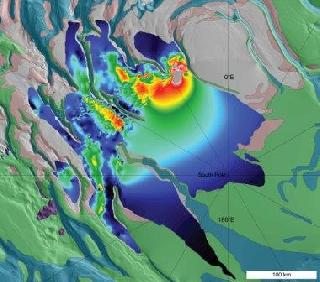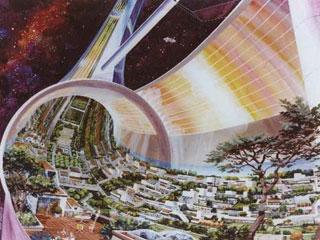
Thickness Map of Buried Carbon-Dioxide Deposit. Photo by NASA/JPL-Caltech/Sapienza University of Rome/Southwest Research Institute.
PASADENA, CALIFORNIA (BNS): NASA's Mars Reconnaissance Orbiter has discovered the total amount of atmosphere on Mars changes dramatically as the tilt of the planet's axis varies.
This process can affect the stability of liquid water, if it exists on the Martian surface, and increase the frequency and severity of Martian dust storms, according to a study published in journal Science.
Using the orbiter's ground-penetrating radar, provided by the Italian Space Agency, researchers identified a large, buried deposit of frozen carbon dioxide, or dry ice, at the Red Planet's South Pole.
The scientists suspect that much of this carbon dioxide enters the planet's atmosphere and swells the atmosphere's mass when Mars' tilt increases.
The newly found deposit has a volume similar to Lake Superior's nearly 3,000 cubic miles (about 12,000 cubic kilometers). The deposit holds up to 80 percent as much carbon dioxide as today's Martian atmosphere.
Mars' atmosphere is about 95 percent carbon dioxide, in contrast to Earth's much thicker atmosphere, which is less than .04 percent carbon dioxide.
"We already knew there is a small perennial cap of carbon-dioxide ice on top of the water ice there, but this buried deposit has about 30 times more dry ice than previously estimated," said Roger Phillips, deputy team leader for the Mars Reconnaissance Orbiter's Shallow Radar instrument.
"We identified the deposit as dry ice by determining the radar signature fit the radio-wave transmission characteristics of frozen carbon dioxide far better than the characteristics of frozen water," said Roberto Seu of Sapienza University of Rome, team leader for the Shallow Radar and a co-author of the new report.
"When you include this buried deposit, Martian carbon dioxide right now is roughly half frozen and half in the atmosphere, but at other times it can be nearly all frozen or nearly all in the atmosphere," Phillips said.
"A tilted Mars with a thicker carbon-dioxide atmosphere causes a greenhouse effect that tries to warm the Martian surface, while thicker and longer-lived polar ice caps try to cool it," said co-author Robert Haberle, a planetary scientist at NASA's Ames Research Center.
"Our simulations show the polar caps cool more than the greenhouse warms. Unlike Earth, which has a thick, moist atmosphere that produces a strong greenhouse effect, Mars' atmosphere is too thin and dry to produce as strong a greenhouse effect as Earth's, even when you double its carbon-dioxide content."
 Previous Article
Previous Article Next Article
Next Article













The Indian Air Force, in its flight trials evaluation report submitted before the Defence Ministry l..
view articleAn insight into the Medium Multi-Role Combat Aircraft competition...
view articleSky enthusiasts can now spot the International Space Station (ISS) commanded by Indian-American astr..
view article